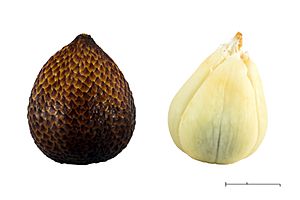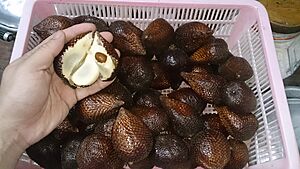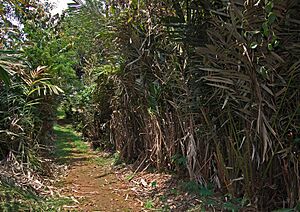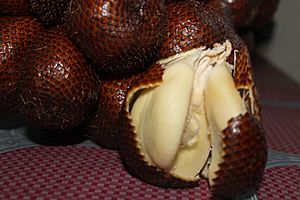Salak facts for kids
Quick facts for kids Salak |
|
|---|---|
 |
|
| Salak fruit (Salah pondoh cultivar) | |
| Scientific classification | |
| Kingdom: | |
| (unranked): | |
| (unranked): | |
| (unranked): | |
| Order: | |
| Family: | |
| Genus: |
Salacca
|
| Species: |
S. zalacca
|
| Binomial name | |
| Salacca zalacca (Gaertn.) Voss
|
|
| Synonyms | |
|
|
The Salak (scientific name: Salacca zalacca) is a type of palm tree. It belongs to the palm family, called Arecaceae. This plant originally comes from the islands of Java and Sumatra in Indonesia.
People grow Salak trees in many parts of Indonesia to harvest their tasty fruit. It also grows naturally in places like Bali, Lombok, Timor, Maluku, and Sulawesi.

The Salak tree has a very short stem. Its leaves can grow up to 6 meters (about 20 feet) long. Each leaf has a long stem, called a petiole, which can be 2 meters (about 6.5 feet) long. These petioles have sharp spines, up to 15 centimeters (6 inches) long. The leaves also have many smaller parts called leaflets.
The fruits grow in bunches at the bottom of the palm tree. They are often called snake fruit because their reddish-brown skin looks like snake scales. Salak fruits are similar in size and shape to a ripe fig, with a small point at one end. The inside part of the fruit is safe to eat.
You can peel the fruit by pinching its tip. This makes the skin loosen so you can pull it off. Inside, the fruit has three parts, or lobes. The two bigger lobes, or sometimes all three, contain a large seed that you cannot eat. The lobes look a bit like large peeled garlic cloves.
The taste of Salak fruit is usually sweet and a little bit sour. It can also have a slightly dry, sharp taste. The texture is like an apple, but it can be different depending on the type. For example, salak pondoh from Yogyakarta is dry and crumbly. Salak Bali is more moist and crunchy.
Growing Salak Trees

People have been growing Salak trees all over Indonesia for a long time. There are at least 30 different kinds, or cultivars, of Salak. Most of them taste a bit sharp but are also sweet. Two very popular types are salak pondoh from Yogyakarta and salak Bali from Bali island.
Salak Pondoh
Salak pondoh is a very important fruit in the Yogyakarta area of Java island. In just five years, by 1999, the amount of salak pondoh grown there doubled. This type of Salak is very popular with people in Indonesia. They love its strong smell and sweet taste, even before it is fully ripe.
There are three special kinds of salak pondoh:
- pondoh super
- pondoh hitam (which means black pondoh)
- pondoh gading (which means ivory or yellowish-skinned pondoh)
Salak Bali
Salak Bali is a common fruit sold all over the island of Bali. It is a favorite fruit for both local people and tourists visiting the island.
This fruit is about the size of a large fig. It has a crunchy and moist texture. When you eat it, it feels a bit starchy in your mouth. Its flavor reminds some people of a mix between pineapple and lemon juice, but not as strong.
Salak Gula Pasir
The most expensive type of Salak Bali is called gula pasir. This name means "sand sugar" or "grain sugar" because of its fine texture. It is smaller than other Salak fruits and is the sweetest of all Salak types. In Bali, it can cost between 15,000 and 30,000 Rp per kilogram. This is about US$1.50 to US$3.00, depending on the time of year.
Salak gula pasir is also known as Sugar Salak because it is so juicy and sweet. Sometimes, this sweet Salak is used to make Salak wine. This wine has about 13.5 percent alcohol, which is similar to wine made from grapes.
Images for kids
See also
 In Spanish: Salacca zalacca para niños
In Spanish: Salacca zalacca para niños




